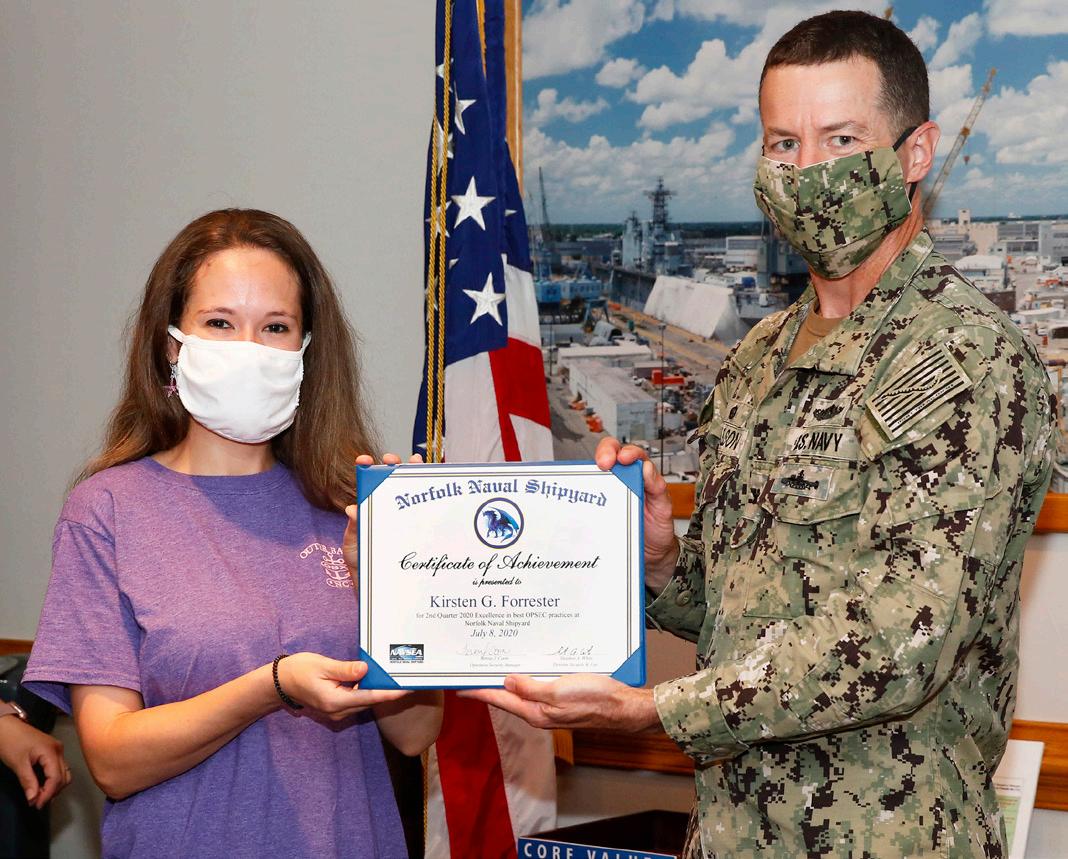
37 minute read
CODE 130 WINS SECOND
CODE 130 WINS SECOND QUARTER OPSEC AWARD
STORY BY KRISTI BRITT • PUBLIC AFFAIRS SPECIALIST I PHOTOS BY TONY ANDERSON • NNSY PHOTOGRAPHER
Advertisement
Each quarter a competition is held at Norfolk Naval Shipyard (NNSY) to determine which shop or code showcases excellence in the practices of Operations Security, or OPSEC. For the first time in the award’s history, the Quality Assurance Department (Code 130) has claimed victory for the second quarter of 2020.
OPSEC is the systematic method used to identify, control, and protect critical information and subsequently analyze friendly actions associated with military operations and other activities. All shipyard employees are expected to do their part in protecting information, storing and disposing of information properly so that it doesn’t fall into the wrong hands. With the help of each code’s designated OPSEC Coordinator, departments strive to achieve the goal of protecting NNSY and the nation as a whole.
“We are constantly on the move ensuring our shipyard is doing their part in protecting critical and unclassified information,” said OPSEC Manager Teresa Coon. “For these awards, we do a thorough search through the codes, scanning for storage of information, checking trashcans, speaking with team members to see what they know about OPSEC and if they have the proper documentation with them. It’s a competition between the shops and codes, everyone striving to be the best at practicing OPSEC.”
Code 130 was awarded July 16 for their significant improvement in ensuring each team member is controlling information as needed. The team received the OPSEC flag and pennant, as well as the Purple Dragon Trophy to display in their code for the quarter. In addition, Code 130 OPSEC Coordinator Kirsten Forrester was presented with a certificate of achievement for her efforts in leading the charge for OPSEC within the code.
“Kirsten has been with us for about a year and has constantly gone above and beyond with everything she does for the shipyard,” said Quality Assurance Director George Fitzgerald. “With her leading the charge, our team does a phenomenal job each and every day. I’m extremely proud of everyone and I’m excited to see where we go from here.”
Forrester said, “I’m very honored to receive this award on behalf of our code. We’ve made history today and I know we’ll continue to do our best. Now that we have this award, we’re going to continue to fight to keep it.”
Fitzgerald added, “We expect never to lose this award now that we’ve seen what our hard work has accomplished. We challenge the rest of America’s Shipyard to step up to the plate because we’re not going down without a fight.”
To learn more about OPSEC, visit https://www.navy.mil/ ah_online/opsec/.

LEFT: Norfolk Naval Shipyard Commander, Capt. Kai Torkelson, presents Code 130 OPSEC Coordinator Kirstern Forrester with a Certificate of Achievement for her efforts in leading her code in protecting critical and unclassified information; RIGHT: The Quality Assurance Department (Code 130) won the Second Quarter OPSEC Award for 2020. For the first time in the award's history, Code 130 claimed victory for their ability to protect critical and unclassified information.
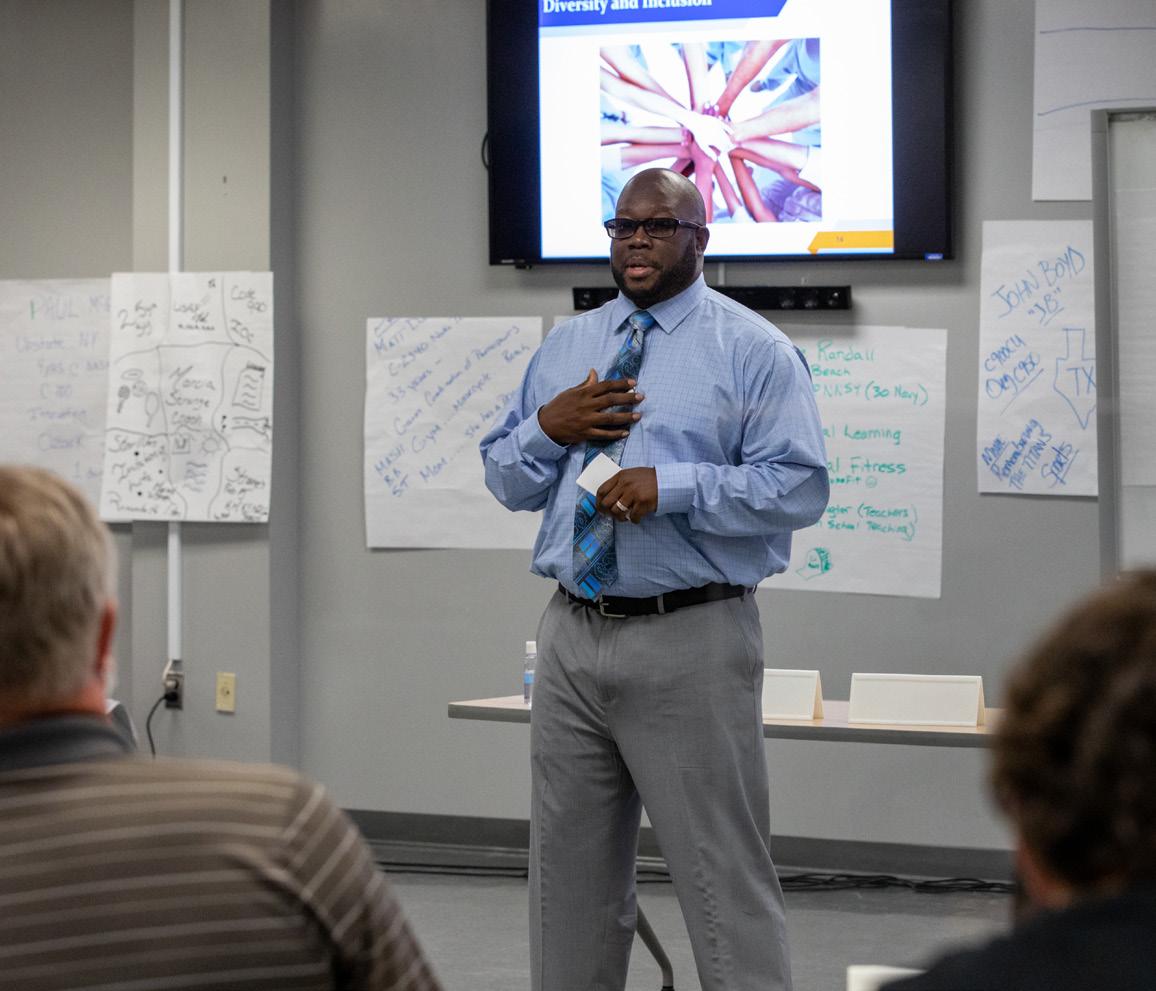
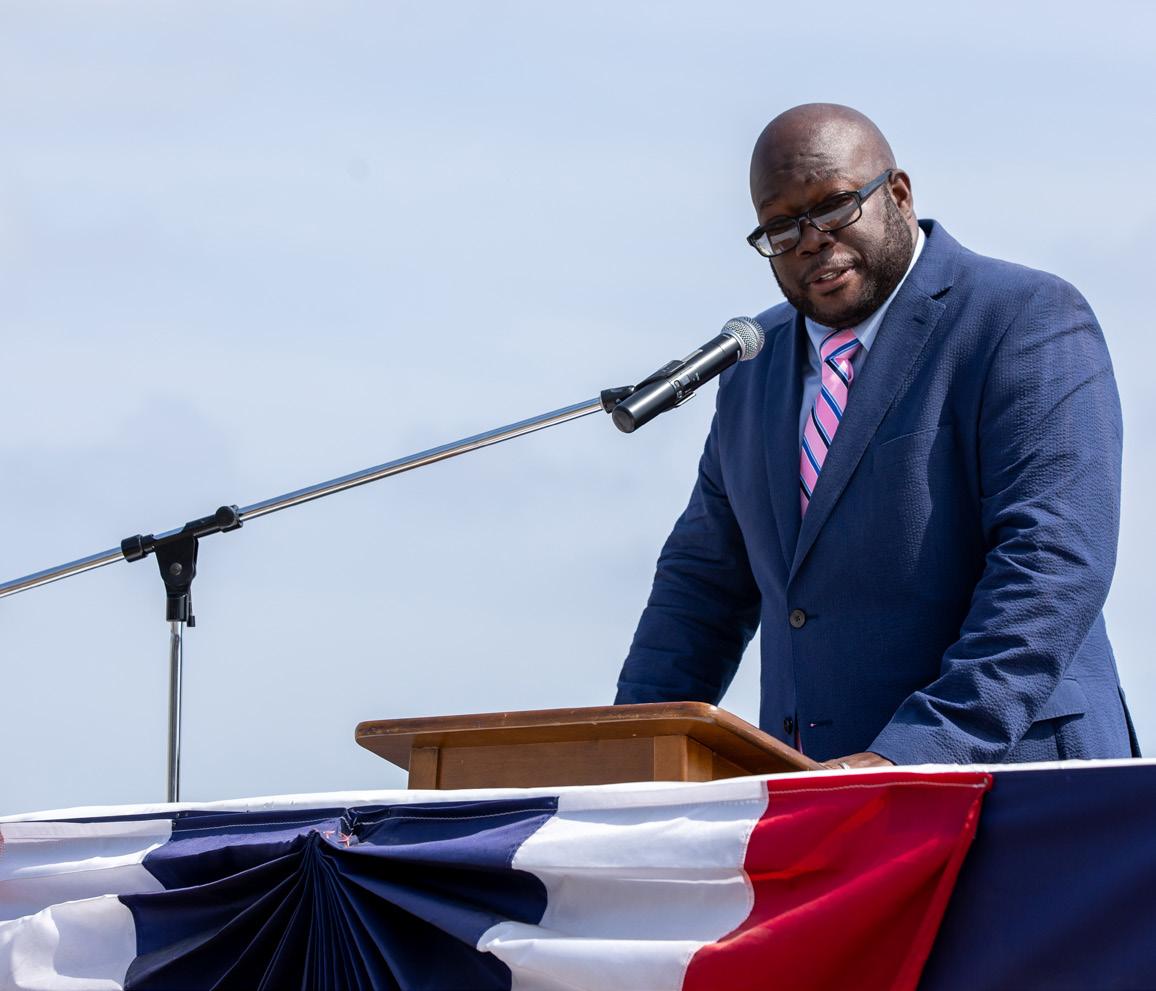
LEFT TO RIGHT: New Diversity and Inclusion (Code 1103) Director Tarane Parker teaching a Third Level Management class from a safe distance away from the students. Throughout the duration of the class, students were divided by glass screens and wore masks; Norfolk Naval Shipyard Diversity and Inclusion Director Tarane Parker spoke at the “Unity at our C.O.R.E.” command event June 9. “The Unity at our C.O.R.E. Command Event was set up to bring NNSY together to address the issues, acknowledge that our workforce is experiencing a myriad of emotions, and encourage everyone to come together and unite as one. There is no better time to advocate for change than now,” said Parker.
SHIPYARD SPOTLIGHT: TARANE PARKER STORY BY HANNAH BONDOC • PUBLIC AFFAIRS SPECIALIST PHOTOS BY SHELBY WEST AND DANNY DEANGELIS • NNSY PHOTOGRAPHERS
On Jun. 9, Tarane Parker made his debut as Norfolk Naval Shipyard’s (NNSY) Director of Diversity and Inclusion (Code 1103) when he spoke at the Unity at Our C.O.R.E. command event. The event was meant to highlight the C.O.R.E. values of Care, Ownership, Respect, and Excellence while addressing the grief the shipyard was sharing with the nation over George Floyd’s death and to discuss the how NNSY would fight racism within its workforce. Well-spoken and well received at the event, some might have wondered who was this new man in town. However, for those who know him, Tarane Parker has actually been part of the NNSY family longer than he has been Code 1103 Director.
Growing up in Youngstown and Cleveland, Ohio with his brother, he was raised by a single mother. He graduated six months early from Bedford High School and joined the Navy in 1995. After 11 years, he transitioned into the civilian workforce, when he was honorably discharged for an injury. Parker obtained his associate’s degree in Electro-Mechanical Control Technology from Tidewater Community College, and started a job at NNSY as an electrician in the Electrical Shop (Code 950). Since then, he has worked in various other codes, earned his Bachelor’s degree in Leadership Development from Old Dominion University and eventually worked his way up to the Director of Diversity and Inclusion.
Parker wanted to become Code 1103’s Director because he wanted to make a difference. “Diversity and Inclusion has always been near and dear to my heart. Regardless of race, sex, ethnicity, gender, or sexual orientation, people are people. They deserve opportunities and I wanted to be a bigger part of that,” Parker said.
Parker already has some goals in mind for his new position. “In the short term, I want to introduce more development and inclusivity training for those who may not understand what that truly means, and to help overcome and address biases people may have,” Parker explained. “Long term, the goal is to expand the footprint of Code 1103 a little further, especially during a time as critical to our country as this.” Additionally, he wants to coordinate with the other Diversity and Inclusion offices and restart some of the diversity conferences and symposiums that have been postponed since the beginning of COVID-19 in a safe manner.
Circling back to his debut, Parker had a roaring start with the Unity at our C.O.R.E. event, but he admitted he was nervous beforehand as he had to deliver his speech to dozens of masked employees waiting to hear what he had to say on such a controversial topic. “The pressure was huge in having to come up with the right words to get my point across without offending anyone per se,” he recounted. “Prior to the speech, I had knots in my stomach. When it was time to deliver the speech however, that feeling went away and I was able to say a lot of what I needed to say.”
In true team player fashion, he credited his mentors for helping him prepare for his role—specifically, his mentor from his time in the Executive Development Program and friend, SES Nuclear Engineering and Planning Department Head (Code 2300) Steve Fahey from Portsmouth Naval Shipyard. “Fahey called me the morning of the event and told me ‘You’ve got this. Share your voice, be your authentic self, and say what needs to be said and how you feel,’” Parker explained. “He looks beyond the pay grade, sees the
10 Things You May Not Know About Tarane Parker
1. He is currently working on his Master's in Leadership and Organizational Management from Capella University.
2. He roots for Ohio State.
3. His favorite color is blue.
4. He has been happily married for two years and has three kids.
5. He loves to eat anything with chicken.
6. His favorite memory growing up was being a camp counselor because of the diversity of the camp he worked at.
7. He is a music producer and owns the music label, "RedRane Music." The label is a combination of his name and his best friend's name.
8. During his down time, he likes to watch "Wildin' Out."
9. His favorite movie is "Malcolm X."
10. His hero is his mother. The advice from her that he still carries is, "the world is yours and everything in it. All you have to do is apply yourself and go get it."
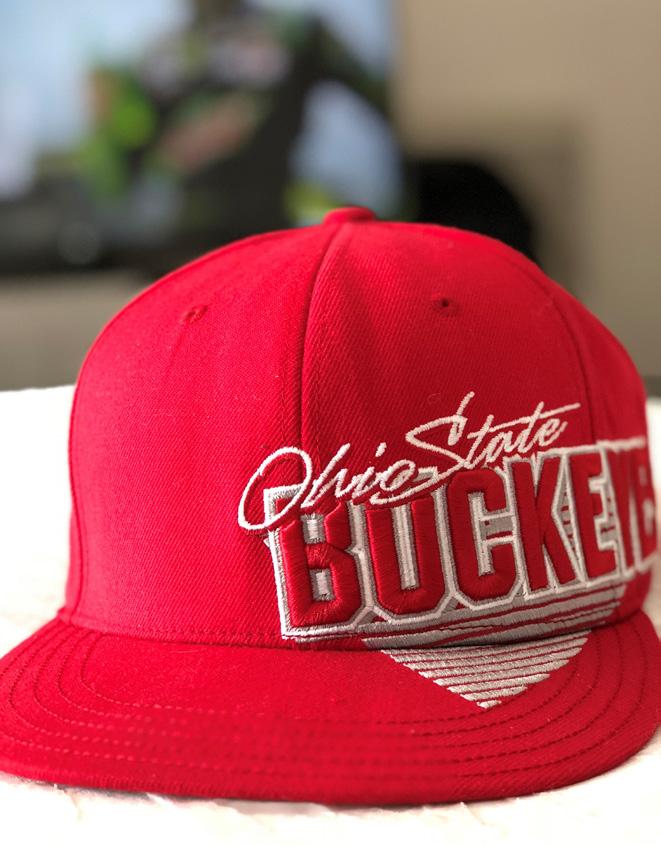

ABOVE: MA1 Brenda Brooks presents the U.S. flag to Diversity and Inclusion (D&I) Director Tarane Parker during the “Unity at our C.O.R.E.” command event June 9. The flag was flown above Norfolk Naval Shipyard June 9 and presented to the D&I team as a symbol of the promise of a more inclusive workplace; BOTTOM: True to his home state, Diversity and Inclusion (Code 1103) Director Tarane Parker is an avid Ohio State fan.
human side of things, and I admire that about him.”
Since the event, Parker’s work has expanded; more people have emailed and called him to discuss topics similar and related to the Black Lives Matter movement. “So many people are voicing their concerns now,” Parker said. “All I can do is try to get to them and help out as many people as I can in a timely manner.”
Most importantly, he wants to ensure that the drive for change does not die down. As Parker explained, “we need to take a deep look at ourselves because that’s where the change starts. Once we figure out the issues within, we can correct them from there, and people will be more willing to let others into their inner circle.”
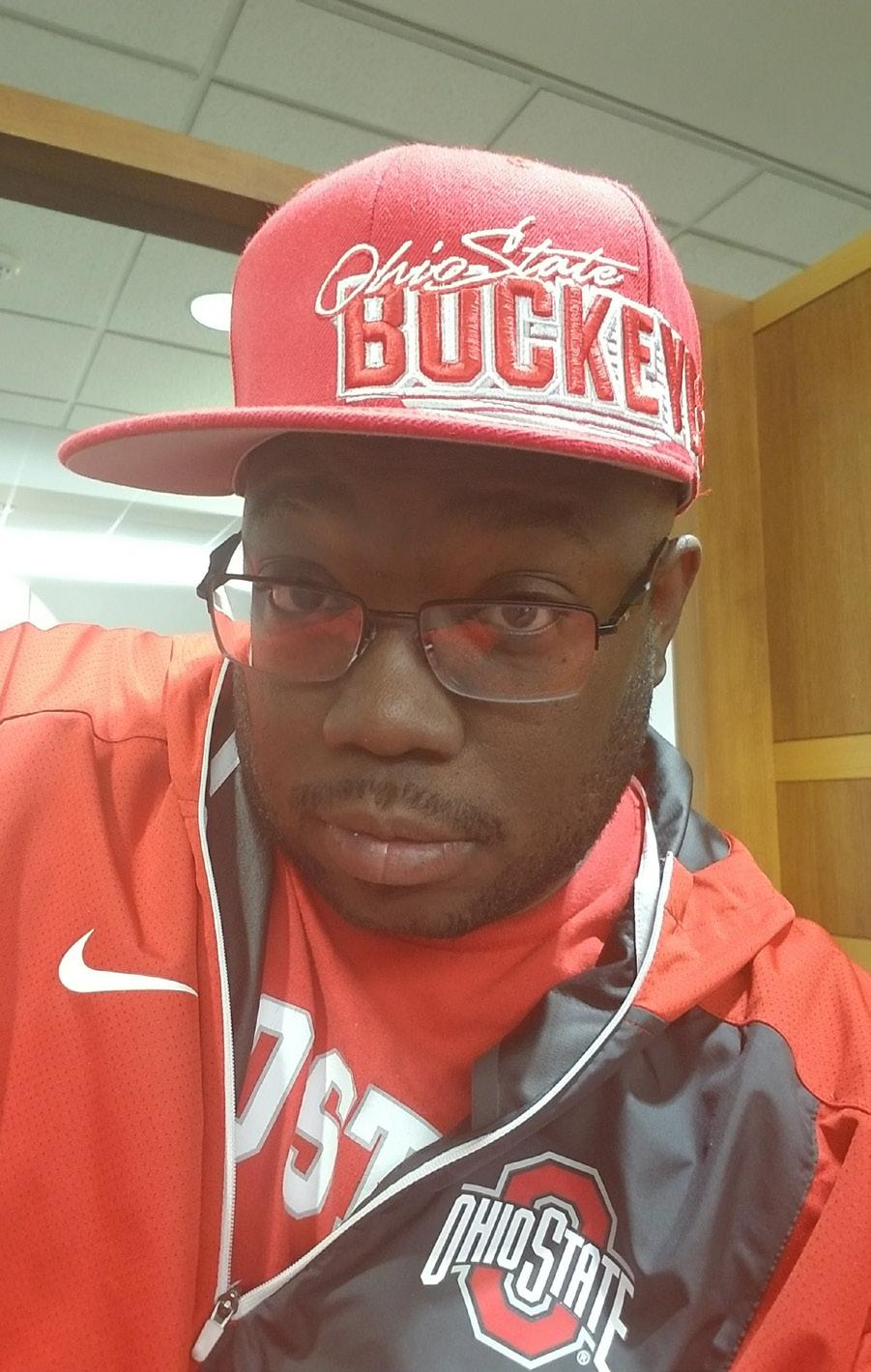
Code 530 JRC Lead Mark Ragsdale shows the various supplies located in the COVID-19 Fight Supplies Warehouse, including the face masks developed in the Sail Loft.
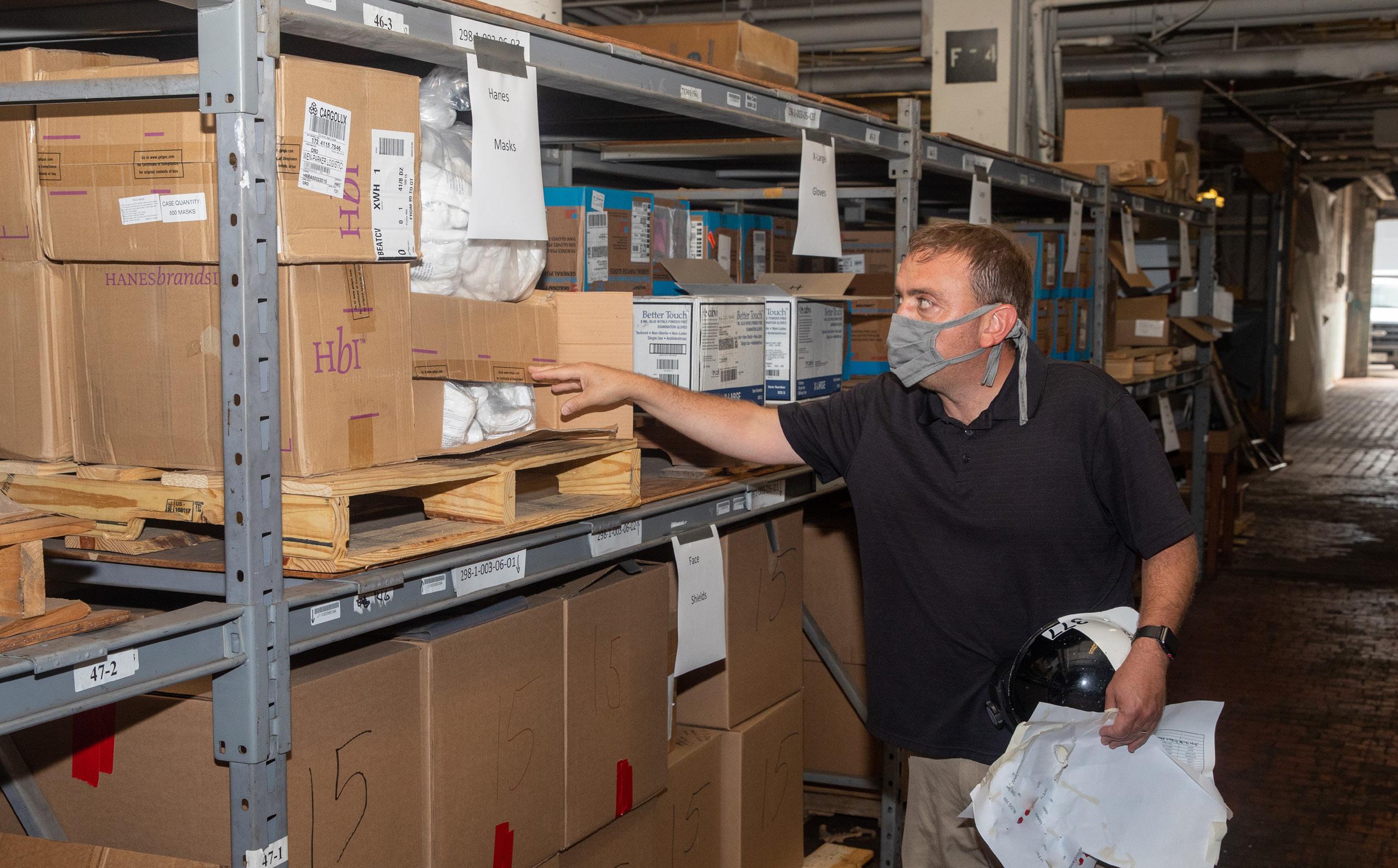
COVID-19 PPE and Cleaning Supplies Team Ensures America’s Shipyard is Fitted with Tools Needed to Minimize the Spread
As COVID-19 continues to impact the nation, Norfolk Naval Shipyard (NNSY) continues its mission to service the fleet. To aid in that mission, a newly established team has come together with a common purpose – ensure America’s Shipyard’s civilians and military have the proper tools to protect themselves and minimize the spread.
The COVID-19 Personal Protective Equipment (PPE) and Cleaning Supplies Team was formed as the virus struck the Hampton Roads community, the urgent needs for supplies bringing a call to action in developing an inventory and getting what’s needed into the hands of our shipyard team. The Job Readiness Cell (Code 530) took charge following its initial startup and was quickly outgrowing its conex box with the amount of supplies being developed in-house and shipped to NNSY. In May, the team was officially moved into Bldg. 298 with their own COVID-19 Fight Supplies Warehouse to store all collected inventory and act as a base of operations for the team to assemble and deliver to the workforce at both NNSY and off-yard.
“We’ve got thousands of supplies that are constantly getting cycled through on a daily basis. We have different types of face masks, face shields, gloves, tech wipes, hand sanitizers, disinfectants and more – and we’re constantly restocking the shelves with what the shipyard is requesting,” said Code 530 JRC Lead Mark Ragsdale. “We want to bring America’s Shipyard the tools needed to fight the invisible enemy, supporting our workforce and our Navy.”
The team takes orders through representatives from each shop or code, building their orders and getting it into their hands as quickly as possible, aiming to have those items in-hand with the customer the same day. "We have refillable stations for hand sanitizer and disinfectant all throughout the shipyard as well as Naval Station Norfolk. Folks can bring their refillable bottles to the stations or we can help them get them filled,” said Boilermaker Darin Spradling, who was assigned to be a control point with the COVID-19 PPE and Cleaning Supplies Team. “We’ve also been sending supplies to Kings Bay, Charleston, Philadelphia, and New York so that all our commands have what they need to keep them safe.”
“We’re currently a first shift crew; however, we are always ready to help our customers,” said Ragsdale. “If folks on backshift have requests, we will have a team in place to help them. Safety is our top priority at the shipyard so we’re going to make sure everyone has the tools to succeed.”
Code 950 Electrical/Electronics Production Manager Krystal Middleton is one of the team’s many customers coming through the pipeline. “It’s been a very positive experience working the with COVID-19 PPE and Cleaning Supplies Team. I coordinated with them and the team was very professional and caring in tending to the urgent needs for Code 950. Quick to display the use of C.O.R.E. values, the team ensured we received our supplies as timely as possible. Within hours we had everything we needed. Their sense of urgency definitely displayed the commitment that this team has in maintaining a safe and healthy environment at America’s Shipyard.”
Code 136.2 Quality Assurance Specialist Cheryl Key also shared her experience with the team. “Throughout this pandemic experience, there have been several personnel throughout the shipyard who have placed their best ‘feet’ forward and showed admirable behavior in a critical moment in time. The COVID-19 PPE and Cleaning Supplies Team has shown to go above and beyond for America’s Shipyard. I reached out to the team in hopes to replenish our hand sanitizer and within minutes I received a response. They verified our location and set up a delivery time. Throughout the entire process, they were upbeat, professional, and kind. My request was taken, evaluated, and answered within a few hours. I’m very thankful for their help and for their willingness to help protect our workforce.”
For Spalding, each day consists of multiple delivery runs around the shipyard, fulfilling the orders requested. “Our group has an important mission to uphold – supply our workforce with the tools they need to keep each other safe. We have folks working nonstop to refill supplies, go through requests and build the deliveries. And we’re happy to do it. For me, I’m ex-Navy and it’s very important to me that we keep our fellow teammates safe. We’re all going through a hard time right now so if we can help even a little bit it’s worth it to me.”
“We’re a well-oiled machine in the COVID-19 PPE and Cleaning Supplies Team,” said Material Handler Contractor James Wideman. “I joined recently and have been very impressed with how we operate here. Our team truly is a testament that the shipyard aims to keep everyone safe. I’m proud to be part of this initiative.”
To request supplies, please email NNSY_COVID_Supplies@ navy.mil.
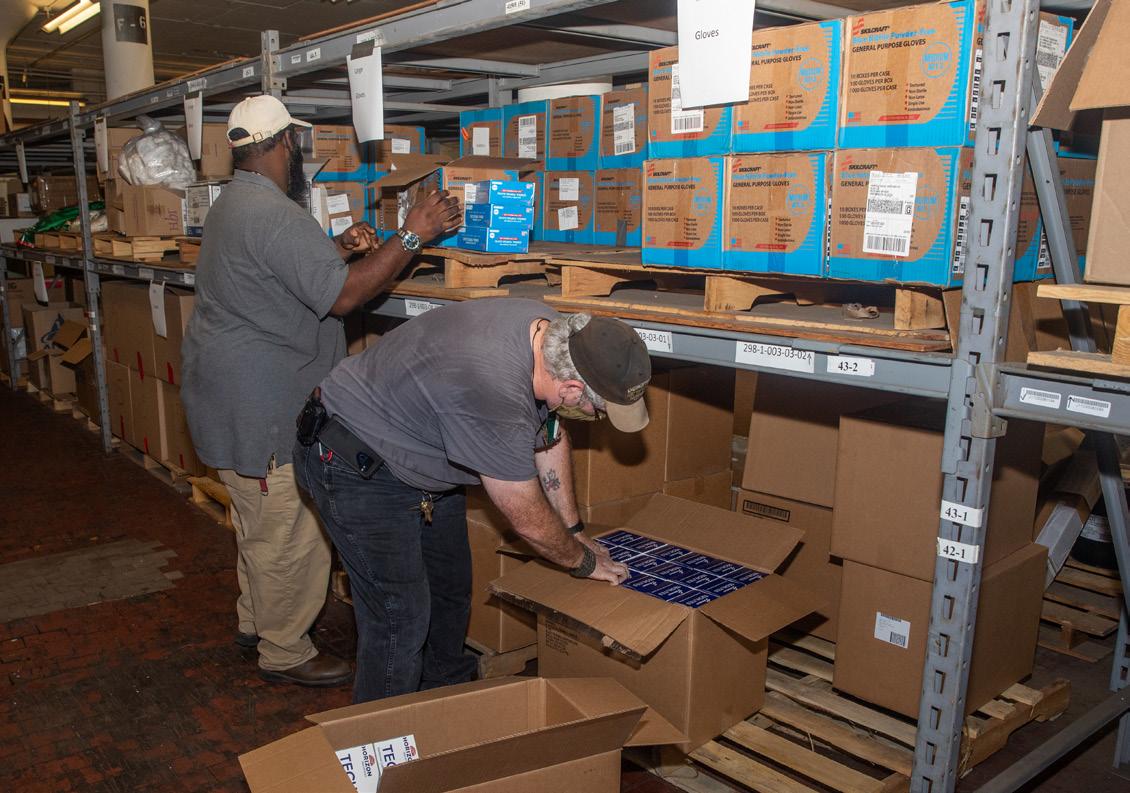
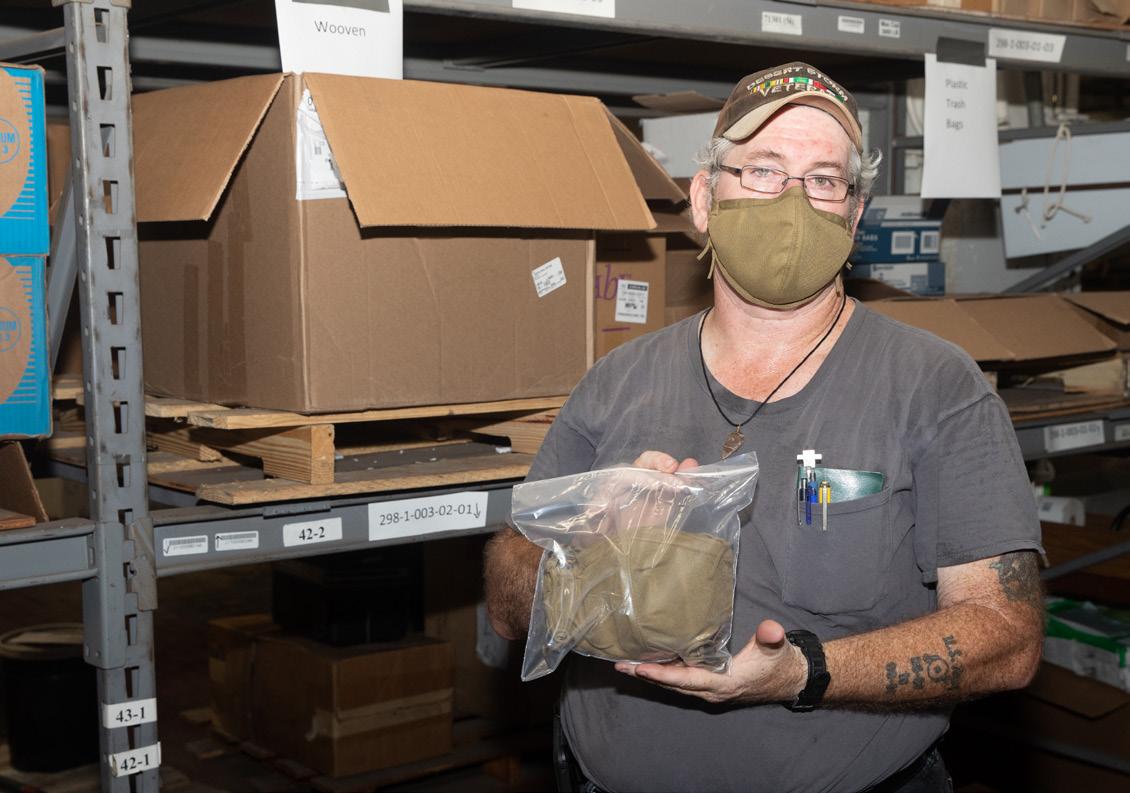
TOP TO BOTTOM, LEFT TO RIGHT: Boilermaker Darin Spradling shows off some of the masks available in the COVID-19 Fight Supplies Warehouse; Boilermaker Darin Spradling and Material Handler Contractor James Wideman build a request order to deliver to a shipyard code; Material Handler Contractor James Wideman shows off a refillable bottle for hand sanitizer that is made inhouse at Norfolk Naval Shipyard; Carrier Assistant Project Superintendent (APS) Tim Riley fills up a hand sanitizer bottle at the refillable station in Bldg. 298.
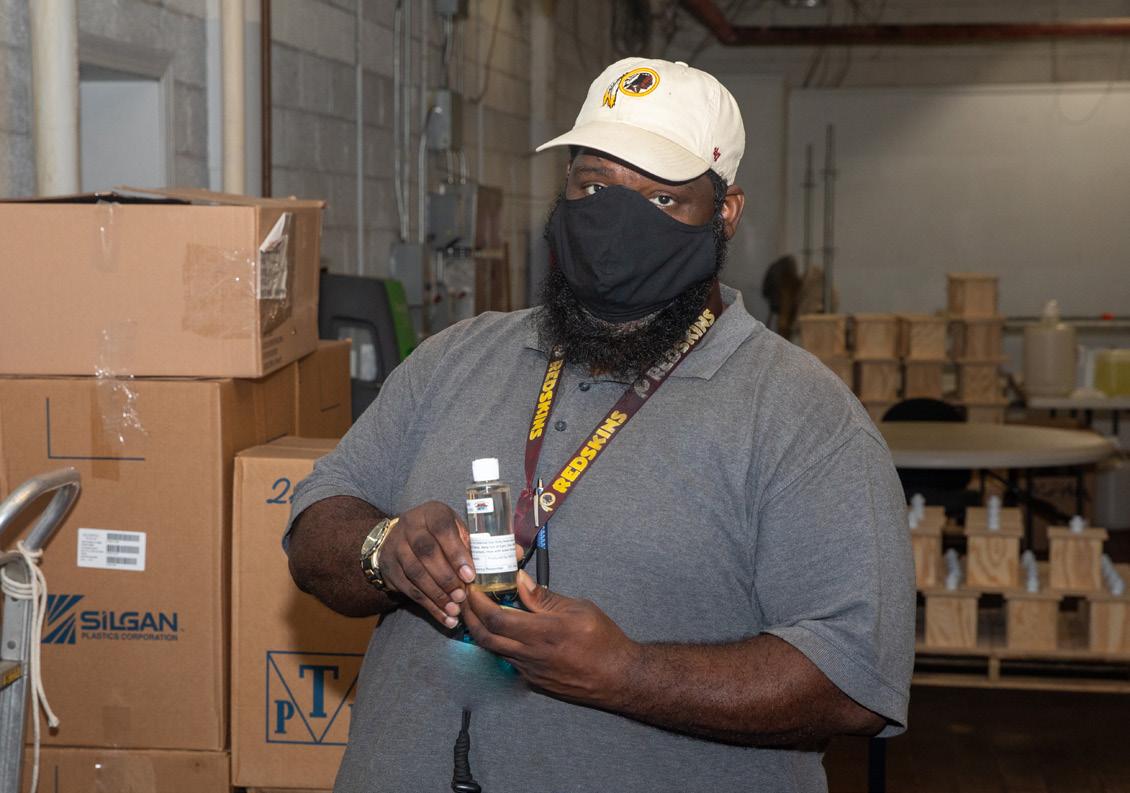
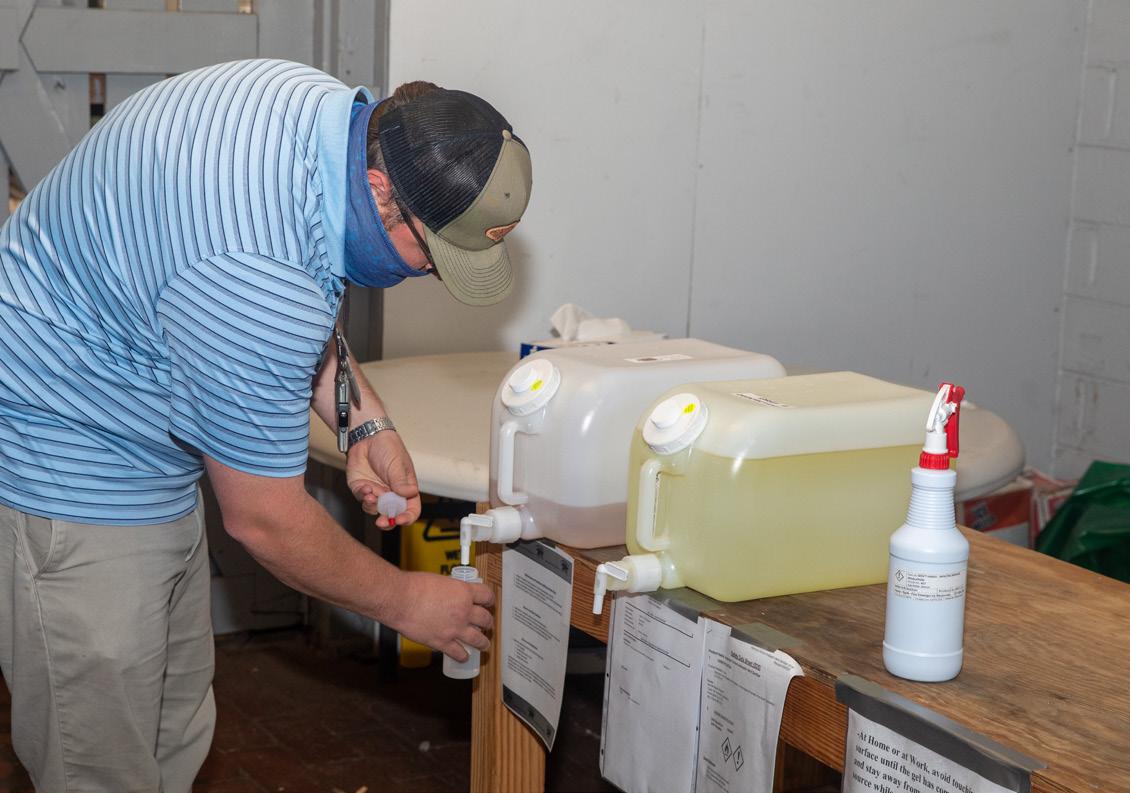
Commemorating the 75th Anniversary of V-J Day: The surprising stories of Norfolk Naval Shipyard’s service during World War II
STORY BY MICHAEL BRAYSHAW • LEAD PUBLIC AFFAIRS SPECIALIST PHOTOS COURTESY OF MARCUS ROBBINS • SHIPYARD HISTORIAN
Its biggest World War II ship was named after a joke the president made. It repaired an ally’s aircraft carrier in secret, while the enemy publically claimed it sunk. It transformed a sabotaged enemy cargo liner into a transport ship carrying thousands of American troops across the Atlantic.
These are just some of the more surprising stories of Norfolk Naval Shipyard’s (NNSY) service as one of the United States Navy’s most vital shipbuilding and repair facilities during World War II. From January 1, 1940, shortly after war erupted in Europe, to its end with Japan on V-J Day August 14, 1945, the shipyard repaired, altered, converted, and worked on approximately 6,850 naval vessels, recorded as more than 27 million tons of naval might. In the midst of urgent repairs and conversions, more than 100 new ships and landing craft were built, and millions of dollars in manufactured products were churned out for the Navy.
To perform its unprecedented amount of work, the shipyard—then known as Norfolk Navy Yard— more than doubled its physical size, turbocharged its productive capacity, and bolstered the workforce from 7,625 at war’s inception to a peak of 42,893 in 1943. In all, this bigger, bloodier sequel to the Great War would have lasting impact at NNSY that still reverberates today.

Fixing to Fight
As its highest priority given the urgency to send ships back out to to rejoin the fight, NNSY devoted more than half its World War II work to repairs. More than 800 ships docked for repair in 1944 alone—an average of more than two per day. To facilitate such a volume of work, skills as shipyard artisans and urgency as patriotic Americans worked in tandem for the thousands of NNSY employees laboring around the clock and across the calendar. Borrowing parts between ships, tapping into the shipyard foundry to make components, developing an extensive salvage system and using quick-drying paints helped speed repairs. In one instance, even the Greyhound Bus Company was called to assist in supplying a diesel engine.
NNSY’s first casualty of World War II arrived May 12, 1941, somehow as quietly as it was sizable. After German dive bombers hammered the British aircraft carrier HMS Illustrious during a seven-hour attack off Malta, it arrived at the Navy yard under its own power to undergo repairs to its flight deck, most of its electrical system, and extensive equipment. Local news media helped keep the carrier’s fate a secret, thanks in part to Secretary of the Navy Frank Knox asking people to keep mum on the matter. The widespread vow of silence proved effective, as during its six months in the yard, German broadcasts claimed on multiple occasions Illustrious had been sunk. In addition to British vessels, French, Canadian, Dutch, Russian, and Australian ships were among the 216 foreign warships repaired or overhauled at NNSY during the war, beneficiaries of the Lend-Lease Bill sharing resources between Allied nations. During several of these repair jobs, shipyarders had to contend with unfamiliar systems on foreign ships.
In the midst of that workload, NNSY repaired the U.S. Navy’s own warships, damaged from bombs, torpedoes and kamikaze attacks alike. These included the heavy cruiser USS Chester (CA-27), damaged near Guadalcanal in October 1942 when a Japanese torpedo hit midship on the portside and smashed the forward engine rooms, killing 11 and wounding 12 more. When the destroyer USS Kendrick (DD612) had its stern heavily damaged by a German dive bomber in September 1943, the shipyard built a new one. After the light cruiser USS Honolulu (CL-48) suffered a portside torpedo attack prior to the Battle of Leyte Gulf in October 1944, NNSY restored it to become a training ship. The Navy yard made a new bow for USS Lindsey (DM-32) after a dramatic and deadly Pacific battle in April 1945 with two kamikaze planes striking the vessel, killing 57 and wounding 57 others. Sometimes multiple repair jobs arrived on the same day, as in the case of USS Hobson (DD-464) and USS Sangamon (CVE-26) in June 1945, both victims
NNSY transformed the 20,000-ton German cargo liner TS Windhuk into the U.S. Navy vessel USS Lejeune (AP-74) beginning in spring 1943 after being captured in South American waters. Over a period of eight months, NNSY workers converted it into a transport ship which subsequently made ten round trips carrying troops across the Atlantic Ocean.

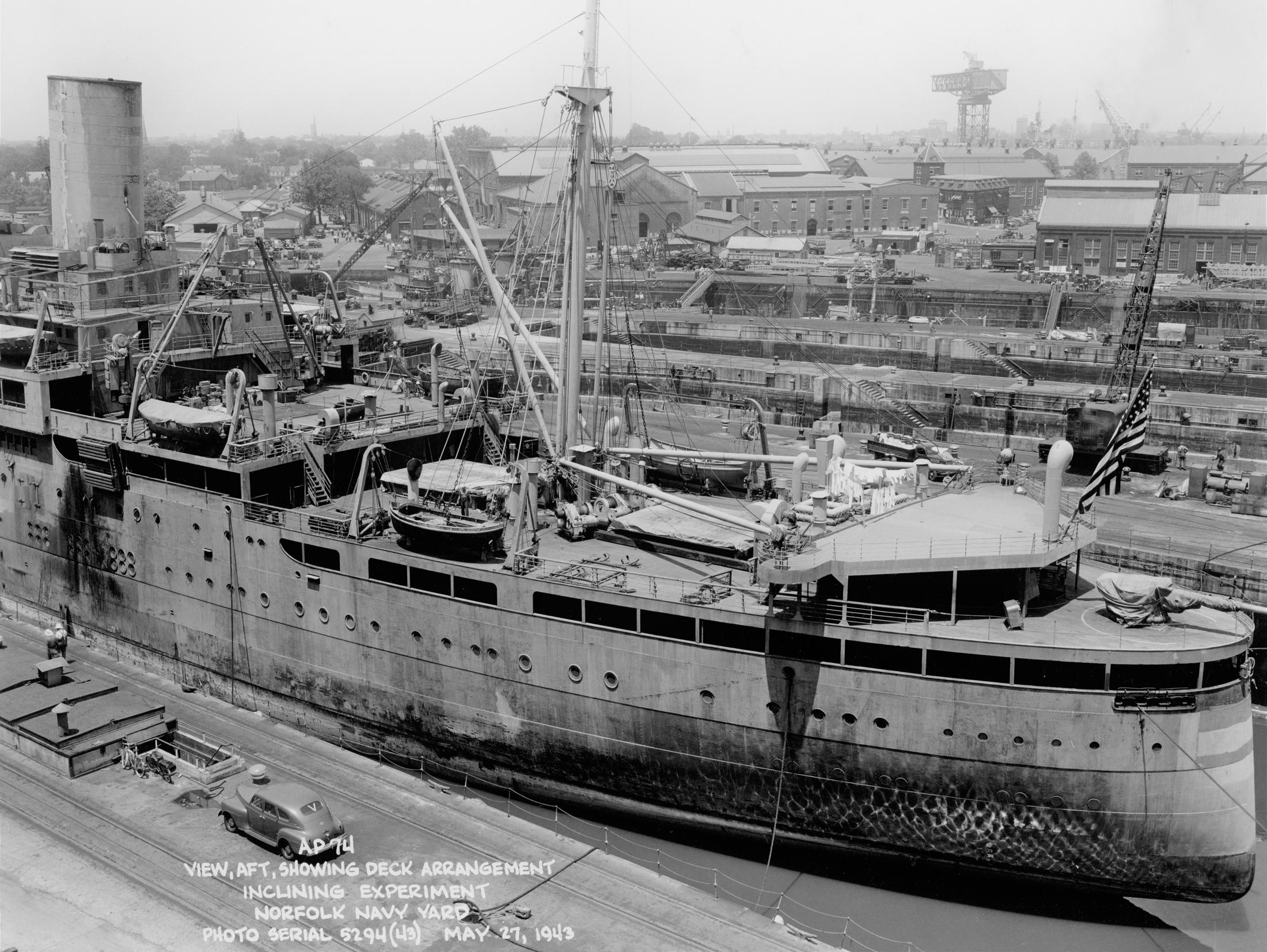
of kamikaze attacks. Whether it be smashed hulls, crippled machinery, or critical electrical equipment to repair, Norfolk Naval Shipyarders married ingenuity and efficiency to quickly fix vessels and return them to sea.
It’s a Sabotage!
Beyond battle repairs, ship conversions and alterations at NNSY may have proved equally significant in helping secure victory. Continually shifting priorities based on naval needs—one week might have been landing craft and cargo ships, while the next was attack transports and command ships—NNSY performed a number of remarkable conversion jobs. Not just limited to changing the type of vessel, but even the country it served, NNSY transformed the 20,000-ton German cargo liner TS Windhuk into the U.S. Navy transport USS Lejeune (AP-74) beginning in spring 1943. The vessel was captured in South American waters after its crew sabotaged it by melting its boiler tubes, pouring concrete into the main propulsion machinery, and using torches to ruin main shaft roller bearings. Over a period of eight months, NNSY workers installed new turbines and boilers, repaired the main shafts, added armament, and repurposed the ship to transport troops. Lejeune subsequently made ten round trips across the Atlantic, able to carry up to 4,650 servicemembers at a pop.
Building for Victory
Given their value in the Pacific during World War II, the shipyard devoted great attention and effort in constructing its three Essex-class aircraft carriers. While
NNSY’s World War II battleship, USS Alabama (BB-60), shown here at its commissioning Aug. 16, 1942, earned nine battle stars providing fire support and anti-aircraft screening in the invasions of Saipan, Guam, and Okinawa. The ship still exists as the centerpiece of the USS Alabama Battleship Memorial Park in Mobile, Alabama. A detailed replica is used as a float in community parades and at various outreach events throughout Hampton Roads.

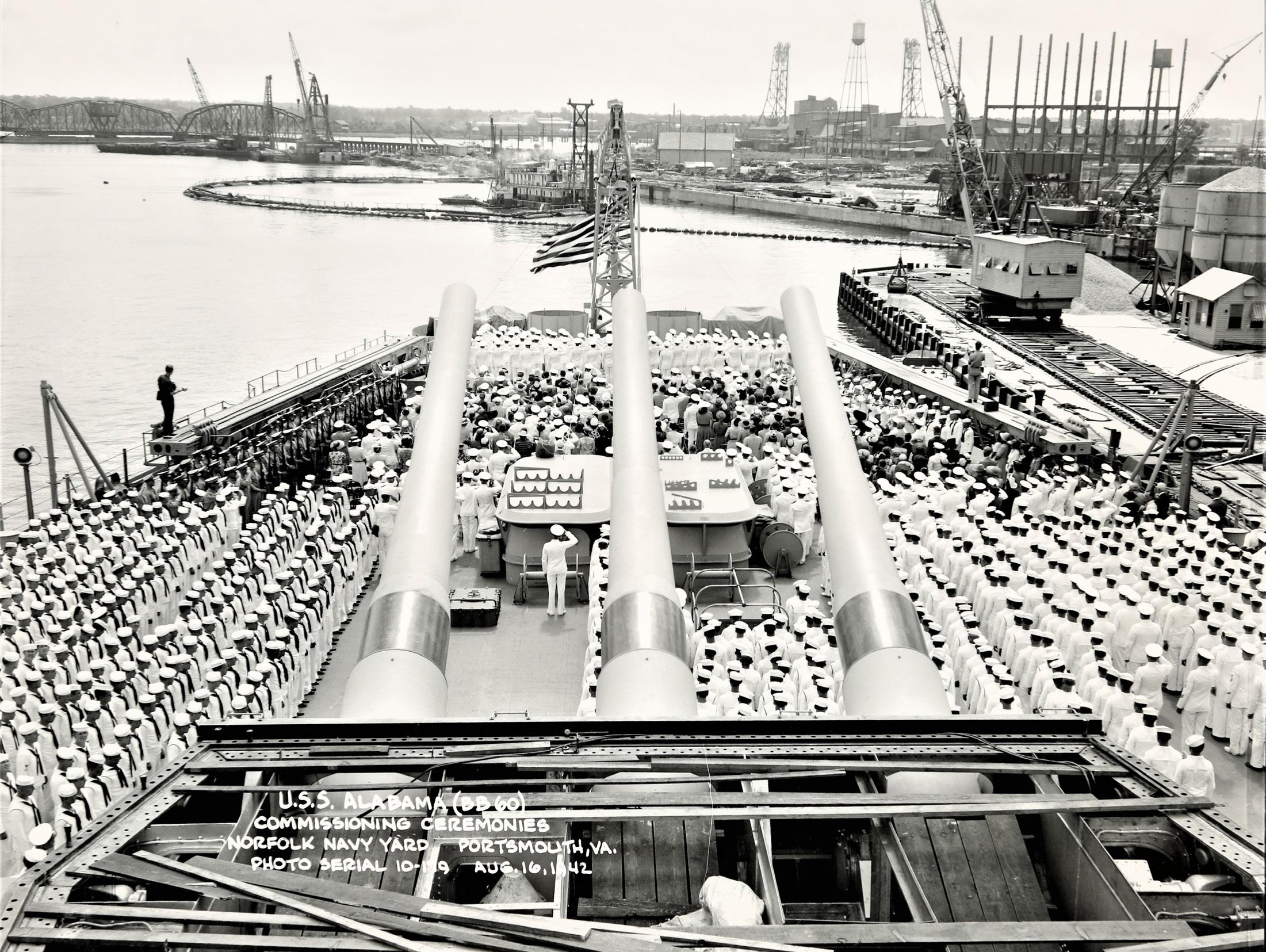
many U.S. carriers of the era were named after pivotal battles in national history, NNSY’s first, USS ShangriLa (CV-38), immediately distinguished itself by being named after a joke. When reporters questioned President Franklin D. Roosevelt about the launch site of the American B-25s making the first bombing raid on Japan in April 1942, he quipped that they came from "Shangri-La,” the mythical land in James Hilton's novel Lost Horizon. In protecting the carrier USS Hornet (CV-8) from enemy retaliation, Roosevelt also inspired the name of a carrier that helped end the war. Reporting to the Fast Carrier Task Force in April 1945, Shangri-La launched air strikes on targets in Tokyo, provided close air support over Okinawa, airdropped supplies to Allied prisoners in Japan and later assumed occupation duties. While NNSY’s other two carriers—USS Lake Champlain (CV-39) and USS Tarawa (CV-40)—were commissioned too late in 1945 to participate in battle, Lake Champlain set speed records transporting more than 5,000 Americans home from Europe as part of Operation Magic Carpet.
The shipyard showcased great versatility in constructing a variety of ships during this period, including the battleship USS Alabama (BB-60), which still exists as a museum ship in its namesake state. Alabama earned nine battle stars providing fire support and antiaircraft screening in the invasions of Saipan, Guam, and Okinawa, blasting Japanese factories and defenses to the end of the war. NNSY’s destroyers USS Herndon (DD-638) and USS Shubrick (DD-639) performed antisubmarine patrol duty and fire support, including on D-Day, as well as escorted troopships across the Atlantic. At war’s end, Herndon sailed to China where a Japanese surrender ceremony took place aboard. In a testament to the Navy yard’s craftsmanship, the unsinkable Shubrick survived multiple deadly attacks, returning to the U.S. on
one screw after being struck by a 500-pound bomb at Palermo, and another return trip on one engine after a kamikaze attack in the Pacific. NNSY also constructed ten destroyer escorts, as well as the minesweepers USS Raven (AM-55), USS Osprey (AM-56) and USS Auk (AM-57), with Raven and Osprey participating in minesweeping in advance of D-Day. NNSY built 50 50-foot landing craft, mechanized (LCM) in summer 1942, able to transport 30 tons of cargo ashore for invasions at Normandy, North Africa, France, Italy and the Pacific islands. The shipyard also built 20 tank landing ships to support a multitude of amphibious assaults in Europe and the Pacific.
Mettle in Manufacturing


Though less dazzling than repairing a crippled aircraft carrier or constructing a 34,800-ton one from scratch, it takes many products and parts to win a war, and NNSY manufactured $200 million worth of goods from 1939 through 1945. Boats of all types, from whale boats to admirals' barges, were built. More than 5,000 diesel engines of three types--25, 65 and 105 horsepower--were built for small boats. Motor blocks and other major parts were cast in NNSY’s foundry, with engines assembled in the yard’s Inside Machine Shop. Many went directly into the small boats being built in the yard, while hundreds of others were shipped out to naval bases. Other manufactured products included metal furniture, anchors, chains and turret castings. Turbine blades, destroyer propellers, bomb casings, bomb racks, other ordnance items, and various machinery parts came from NNSY’s shops.
“World War II left a lasting impact in America’s Shipyard that’s felt even 75 years later, as NNSY doubled in physical size, vastly increased its productive capacity, and proved the possibilities of what can be accomplished when the workforce rallies around a common, vital goal,” said Shipyard Commander Captain Kai Torkelson. “And just as our predecessors did 75 years ago, it’s on the shoulders of every one of us at this great shipyard to maintain our nation’s ships, and deliver unmatched warfighting capability to our nation’s fleet.”
ABOVE: After German dive bombers hammered the British aircraft carrier HMS Illustrious during a seven-hour attack off Malta, it arrived at NNSY under its own power May 12, 1941 to undergo repairs to its flight deck, most of its electrical system, and extensive equipment; RIGHT: NNSY’s most famous aircraft carrier of three built during World War II, USS Shangri-La (CV-38) reported to the Fast Carrier Task Force in April 1945, launching air strikes on targets in Tokyo, providing close air support over Okinawa, and airdropping supplies to Allied prisoners in Japan before later assuming occupation duties.
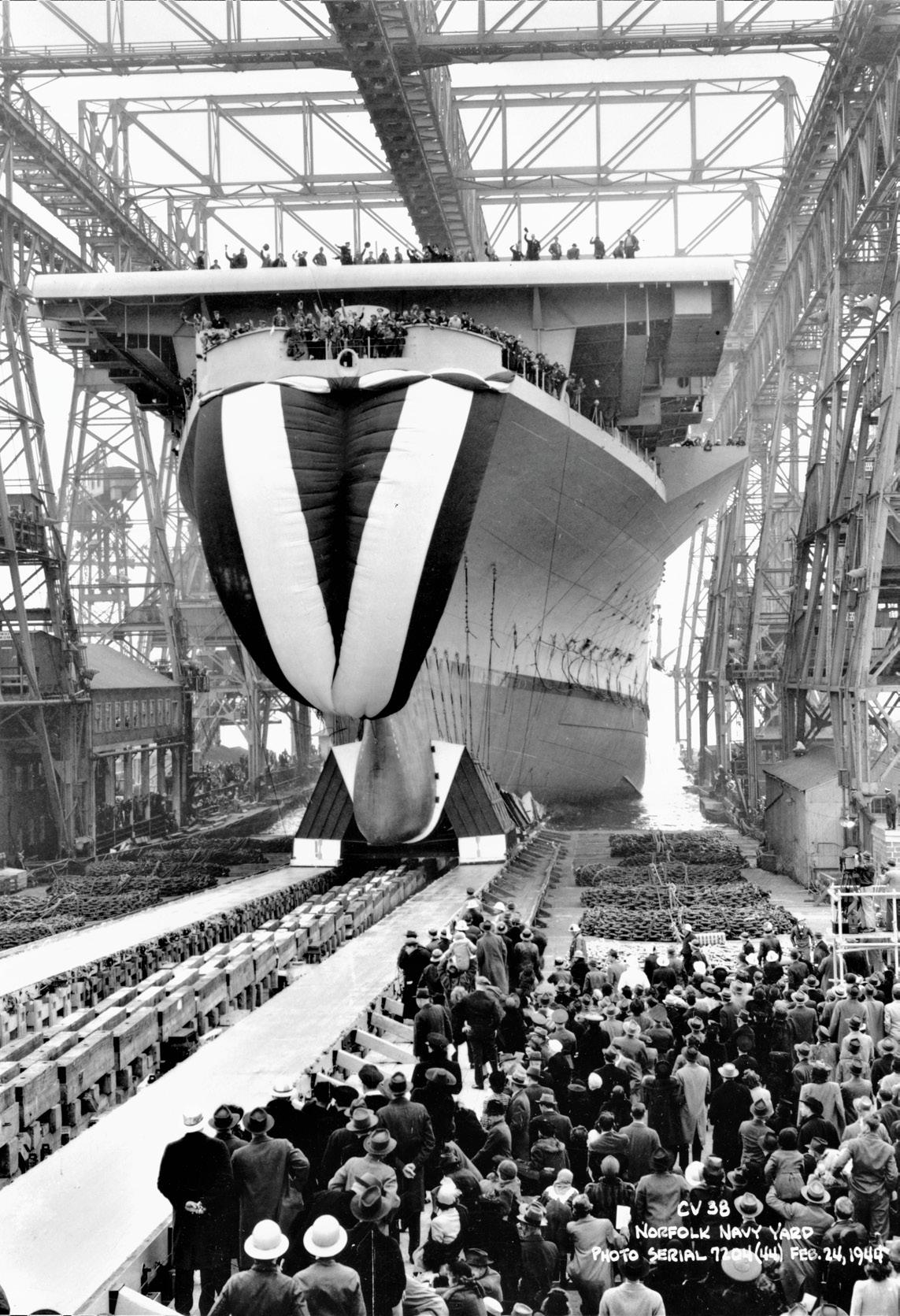
TALKING SHOP
STORY AND PHOTOS BY TROY MILLER • PUBLIC AFFAIRS SPECIALIST
FLEET MAINTENANCE SUBMARINES FMB
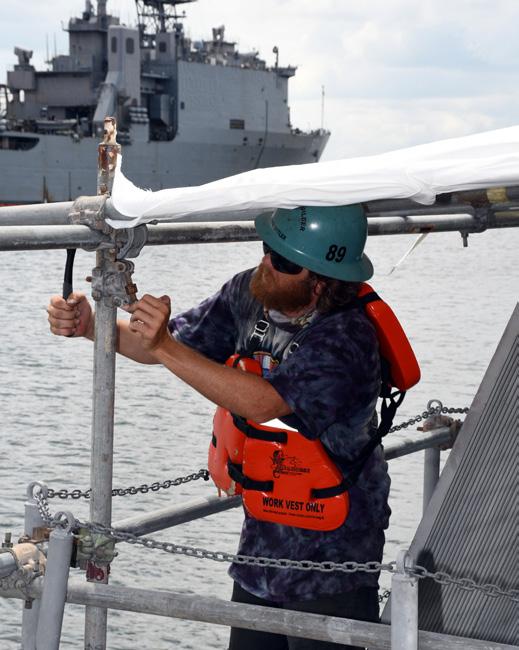
Communication. Can-do attitude. Teamwork. Cross training. These are a few strengths of Norfolk Naval Shipyard’s (NNSY) Fleet Maintenance Submarines (FMB) that helped to significantly increase the amount of maintenance and repairs completed on time.
Through the unprecedented challenges that fiscal year 2020 brought, FMB made some changes in order to keep its delivering on time at one hundred percent for the first three quarters. “We opened up the communication line wider with Submarine Squadron Six who brokers us the work that is needed on the submarines,” said FMB’s Production Management Assistant Lt. Cmdr. Jerod Cole. “Because of this, it helped us to improve our forecasting resources availability and work load availability.”
FMB, an intermediate maintenance facility, is considered to be "a mini shipyard" located at Naval Station Norfolk. Like NNSY itself, FMB has the same shops and codes to perform maintenance and repairs on submarines. Temporary Air Conditioning and Heating, Electrical and Piping Shop (Shop 99), Shipwrights/Scaffolding/Fabric Shop (Shop 89), Inside Machine Shop (Shop 31), Outside Machine Shop (Shop 38), and the Pipefitter Shop (Shop 56), are some of the shops that work together as a team to keep submarines on schedule for underway periods to complete missions.
“We can do most maintenance and repairs that don’t require a dry dock,” said Mast and Antenna Group Shop 67HS’s Work Center Supervisor Machinist Mate Second Class Derek Boulanger.
“NNSY returns submarines back to the fleet, while FMB keeps them in the fleet, so that they can fulfill their mission,” said FMB’s Chief Test Engineer Combat Systems Division Daniel House. “This is why it’s important to ensure we meet our delivery deadlines on time. If we fall behind schedule, then the submarine’s underway schedule could
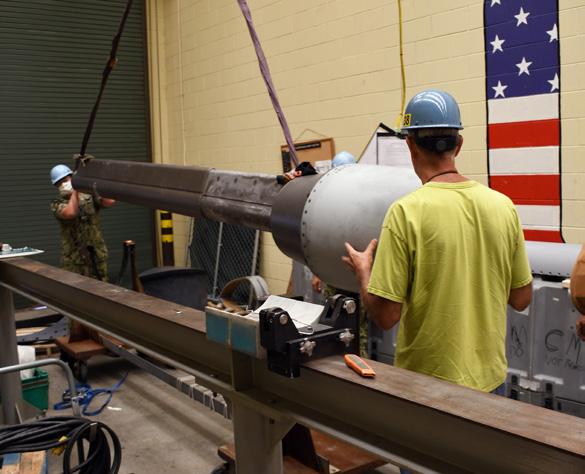
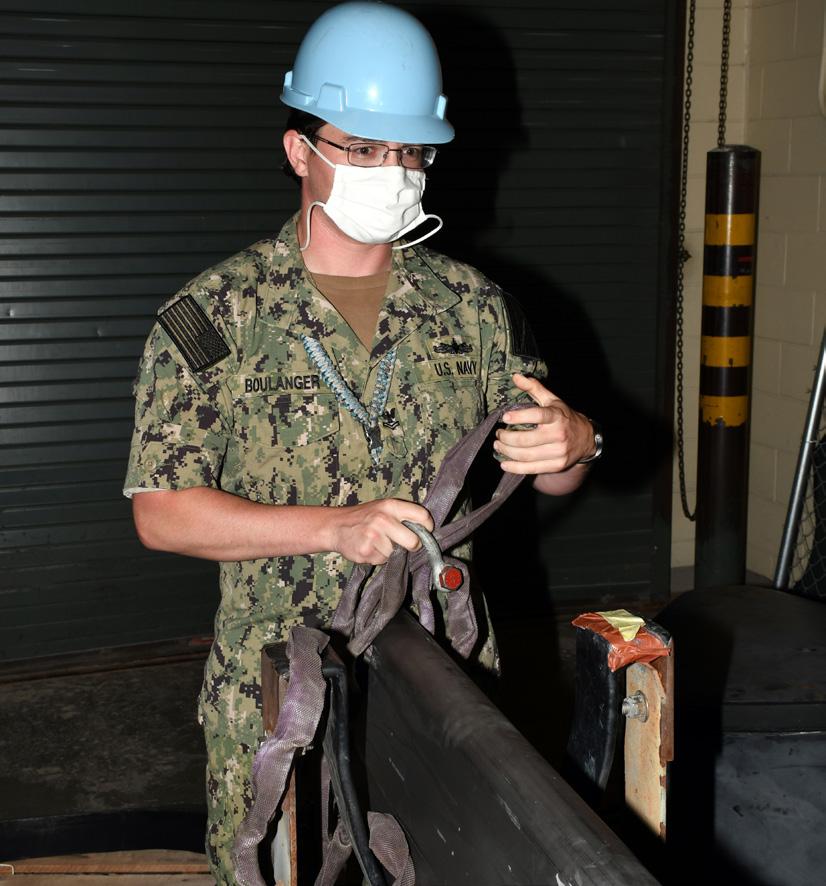
be affected and we do not want that.”
FMB consists of 450 personnel, of which 260 are Sailors and the rest are civilians, unlike NNSY that is made up majority of civilian employees. “Being made up of a majority of Sailors has its benefits,” said Cmdr. England. “The civilians here have a wealth of knowledge and experience. They are able to share that with our young Sailors so that they can be better equipped when they leave FMB and go back to the fleet.”
“Sailors, the end users, are able to communicate their experience of actually operating the equipment while underway to the civilians,” said Lt. Cmdr. Cole. “This gives the civilians a better understanding on how the labor that they put into a project is utilized when the boat leaves FMB and goes underway.”
“Our Fleet Maintenance Submarines (FMB) team has done an exemplary job with timely and quality completion of continuous maintenance availabilities,” said Shipyard Commander Capt. Kai Torkelson. “Recent improvements made at FMB in forecasting resource and workload availability supports our fiscal year 2020 focus area of ensuring a Balanced Command Plan. Also of great importance is the ‘win-win’ exchange between our civilians and Sailors—while the civilians pass on great knowledge to our Sailors that goes back to the Fleet, the Sailors provide perspective to our civilians on why the work of superior quality and reliable delivery is so important to get right.”
Cross training personnel is another tool FMB uses to help keep its deliverability at 100 percent. “If a person has multiple qualifications and certifications we can use them to complete a task if the primary person is not available,” said England. “This way we are not wasting valuable time waiting for someone to perform any given task.”
FMB repairs anything that might be needed, and creativity is a
TALKING SHOP

must. For example, in December 2019, Virginia Class submarine USS John Warner (SSN 785) had to change out a cable in the ballast tank prior to deployment.
“What made this job challenging is that the John Warner was conducting a restriction of movement (ROM) exercise that prevented anyone to board or leave the boat for fourteen days, but we were able to use technology to communicate,,” said England. “We had to get creative and plan ahead to ensure this cable replacement was done safely and on time.”
Being fluid and able to work in a fast-pace environment with an ever changing schedule is paramount at FMB.
Now, FMB looks forward to the fourth quarter of fiscal year 2020. The goal at staying at 100 percent is closer and when they achieve it, it will be the first time in a few years. “There is still a lot of work that needs to be done,” said England. “But this FMB family is ready to take it on.”
Photos left to right: Dustin Spitler, Shop 89 mechanic, installs a scaffold on the vertical launch platform onboard Virginia class submarine, USS New Mexico (SSN 779); Shop 67HS’s Machinist Mate Second Class Derek Boulanger (left) and Shop 38’s Outside Machinist Tim Porter prepares a high data rate antenna for transport to the Virginia class submarine USS Washington (SSN 787); Shop 67HS Machinist Mates Submarine Auxiliary Second Class Tyler Finn operates the crane to prepare a high data rate antenna for transport to the Virginia class submarine USS Washington (SSN 787); Torpedoman’s Mate Third Class Craig Figgins, Code 950, performs a resistance check on a counter measure cable for the Virginia class submarine, USS New Hampshire (SSN 778); Shop 38’s Outside Machinist Loren Nelson Boulanger prepares a high data rate antenna for transport to the Virginia class submarine USS Washington (SSN 787); Shop 67HS Machinist Mates Submarine Auxiliary Second Class Tyler Finn operates the crane to prepare a high data rate antenna for transport to the Virginia class submarine USS Washington (SSN 787).
Women proved during World War II that they could work outside of administrative jobs as they took on production work. Female employees worked as welders, crane operators, machinists, riveters, and guards during the war.
STORY BY ALLISON CONTI • PUBLIC AFFAIRS SPECIALIST PHOTOS COURTESY OF NNSY ARCHIVES
2020 marks the centennial of the adoption of the Nineteenth Amendment, which granted female American citizens the right to vote. Women’s Equality Day is celebrated annually Aug. 26 to commemorate the passing of the amendment.
Norfolk Naval Shipyard’s (NNSY) female workforce dates back further than the Nineteenth Amendment to March 1917 when, in the midst of World War I, the Navy first opened its ranks to women. Approximately 11,275 women volunteered to join the Navy during this time. These “Yeomanettes” served as typists, radio electricians, stenographers, bookkeepers, storekeepers, and drivers. More than 800 Yeomanettes reported to America’s Shipyard, where civilian women also began working in clerical and administrative jobs. NNSY trained hundreds of Yeomanettes before they were transferred to Norfolk Naval Base, now Naval Station Norfolk, for duty. While stationed at NNSY, the Yeomanettes worked all three shifts, including the weekend, and drilled 30 minutes daily. After being discharged in 1919, some of the female volunteers, employees, and Yeomanettes chose to stay at the shipyard and began civilian careers that continued for 30 years.
As America entered World War II, the next wave of female workers arrived at the shipyard’s gates. Akin to Rosie the Riveter, these women proved that they could perform not just administrative and clerical work, but production work as well. During the war, women worked as welders, crane operators, machinists, riveters, deck hands, and guards. By 1940, a number of women joined the shipyard’s Police Division, where they walked beats, patrolled in vehicles, performed security duties, carried out traffic control roles, and accomplished other police functions. By 1942, 12 women were responsible for operating the cranes at the shipyard. Ultimately, more than 5,000 women were employed at America’s Shipyard during World War II and their tireless work helped the allies win the war.
NNSY’s Sail Loft was the first shop to hire women after the war. By 1947, nine women were employed in the Sail Loft. Gradually, in the years following World War II, the shipyard began to again hire more women, with some rising the ranks. In Dec. 1957, Edna Etheridge became the first female senior manager in NNSY history when she was promoted to GS13 Supervisory Budget Specialist in the Comptroller Department, heading the Budget and Statistics Division.
By the 1970s women were working in Shipfitter Shop (Shop 11), Inside Machine Shop (Shop 31), Electrics Shop (Shop 67), Riggers & Laborers Shop (Shop 72), and Temporary Services Shop (Shop 99). 1971 saw the first three female graduates of NNSY’s apprenticeship program and by 1979, the program had its first female valedictorian, Shop 31 apprentice and mother of two, Laura Jeanne Priest, who graduated with a 3.86 GPA. In May 1974, Service to the Fleet reported on Shop 72 employee, Dorothy L. Sharp, the shipyard’s first female foreman. In the article, Sharp gave advice to other female workers: “work hard, accept the opportunities being given in the shipyard, and move up!” The same edition featured Administrative Assistant trainee Barbara Hodges who would go on to become the shipyard’s first female Production Resources Administrative Officer.
In the 1970s, women were not just working in administrative and production roles, but also began to enter the engineering field. An article in the Mar. 1978 edition of Service to the Fleet focused the expanding roles of female engineers at the shipyard, included apprentice graduate and future Virginia Senator Louise Lucas. In recognition of the importance of female employment during this decade, Congress designated the first Women’s Equality Day in Aug. 1973.
Since the 1970s, women have continued to gain employment and rise through the ranks at America’s Shipyard. Today, approximately NNSY has 1,938 employees who identify as female, making up approximately 18 percent of the workforce. In recent years, NNSY has put tools in place to promote women’s equality in the workplace and present opportunity for rising female workers. One of the biggest
tools in place is the Federal Women’s Program (FWP). The FWP’s primary focus is to address female employment needs including recruitment and promotion, training and education, retention and career counseling, and to break down barriers including sex discrimination and harassment.
NNSY’s Diversity and Inclusion Director Tarane Parker says that it is vital that the shipyard value its female employees and their history at America’s Shipyard. “The voices and ideas of all women are extremely important to us accomplishing our mission. They cannot and should not be discounted. We need to value the many as well as the few. There are many women here who are fully capable of leading and deserve and equal opportunity at leading, just like their male counterparts do.”
Norfolk Naval Shipyard’s female workforce is still breaking barriers today. Last year, it was announced that then NNSY Operations Officer Captain Dianna Wolfson would become the first woman commanding officer in the history of all four public shipyards, for Puget Sound Naval Shipyard and Intermediate Maintenance Facility. Capt. Wolfson said, “What’s most cool to me is how this is encouraging to young women and helping them realize there’s no glass ceiling in the Navy. You can do it too!”
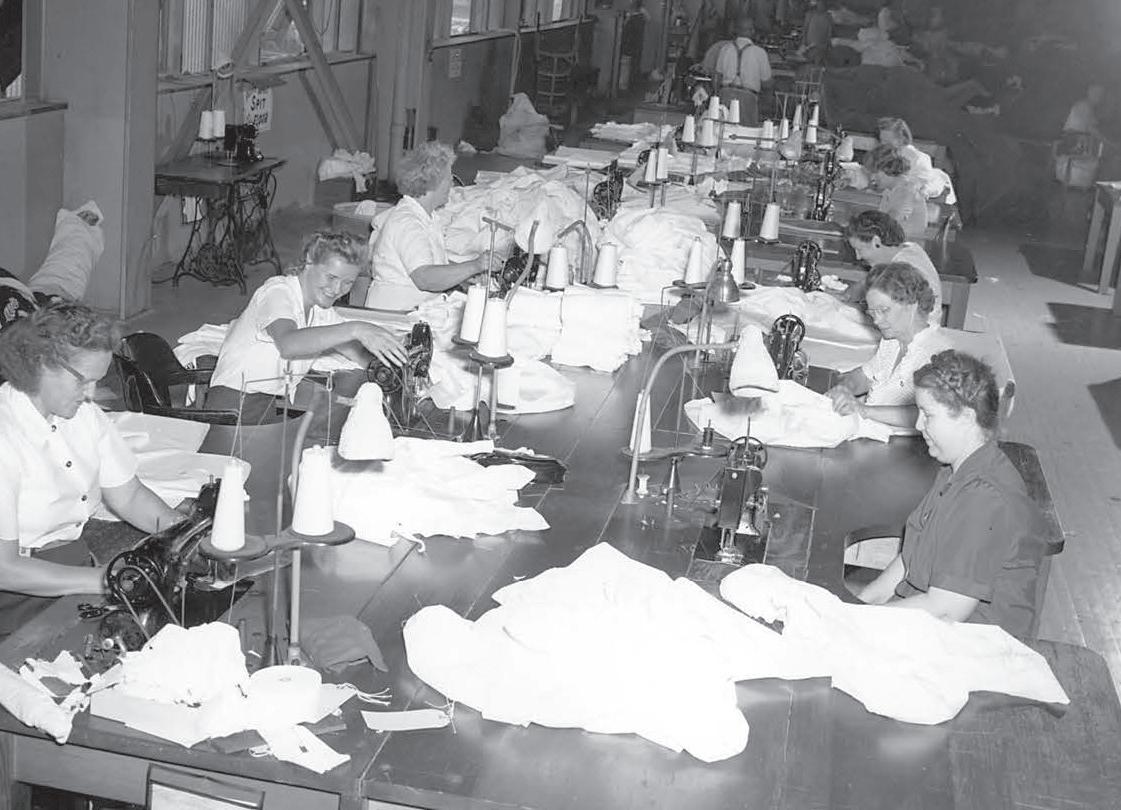
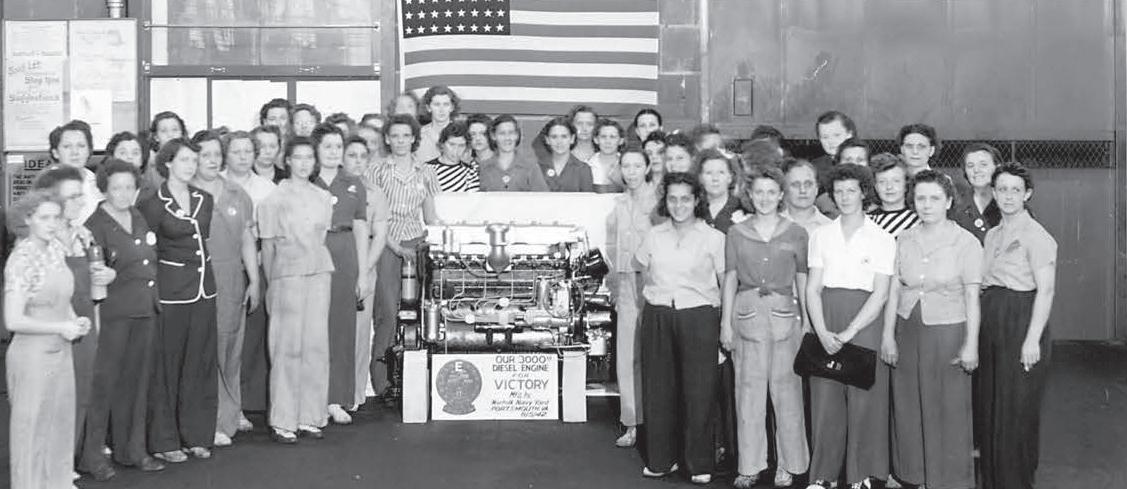
The Sail Loft was the last industrial work place for the 5,000 women who aided in the war effort at NNSY during World War II. The loft also the first production shop to hire women after the war.
Women operating drill presses in the Machine Shop were often called upon to work extended shifts to meet crucial deadlines for building and repairing ships.

These women of the diesel engine shop celebrated the milestone of building 3,000 diesel engines in 1942, then achieved the remarkable total of 5,000 by November 1943.
In 2019, Capt. Dianna Wolfson made history becoming the first female Commanding Officer of any of the four public shipyards.
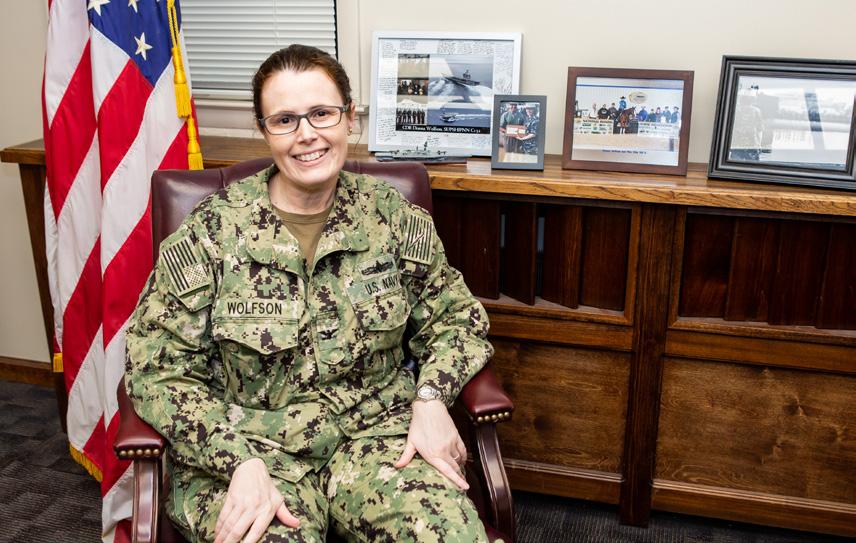
RIGHT: One “first” brought on by World War I was the introduction of female volunteers into the Navy. About 800 “Yeomanettes” performed administrative jobs, issued supplies, ran messages, and drove vehicles at NNSY during the war. After being discharged in 1919, some began civilian careers at the shipyard that continued for more than 30 years; By August 1942, 12 women were handling cranes alone. Working overhead in a crowded machine shop, this female employee is operating a three-ton crane.
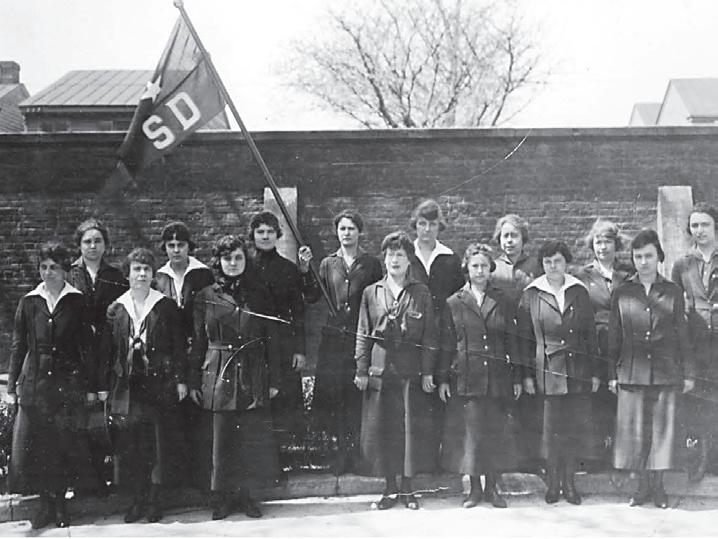
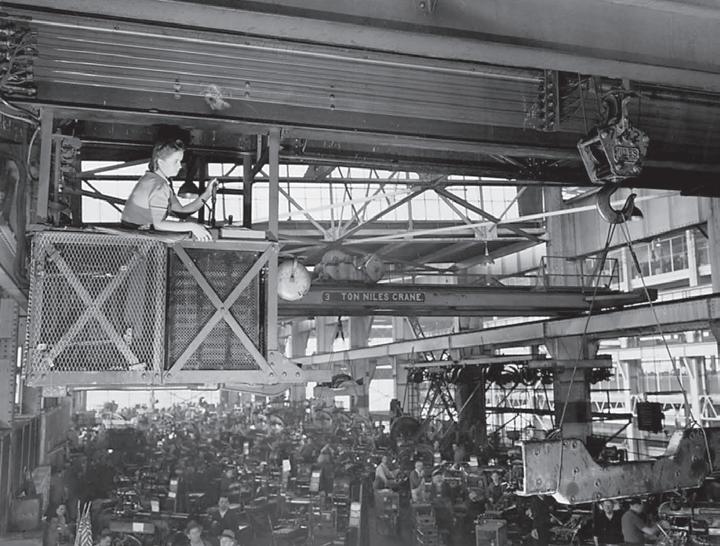
THE C.O.R.E LUNCH BUNCH: NORFOLK NAVAL SHIPYARD’S ASSOCIATIONS TREAT EMPLOYEES FOR GOING ABOVE AND BEYOND IN THE FIGHT AGAINST COVID-19
STORY BY HANNAH BONDOC • PUBLIC AFFAIRS SPECIALIST I PHOTOS BY SHELBY WEST • NNSY PHOTOGRAPHER
LEFT: Naval Civilian Managers Association’s (NCMA) President Andrew Kirby and Federal Managers Association (FMA) Jessica Younger passes out lunches to the NNSY Firefighters; RIGHT: Naval Civilian Managers Association’s (NCMA) Vice President Johnny Satcher passes out lunches to United States Navy (USN) Security Force member Jessica Cooper and NNSY policeman Steven Miller.

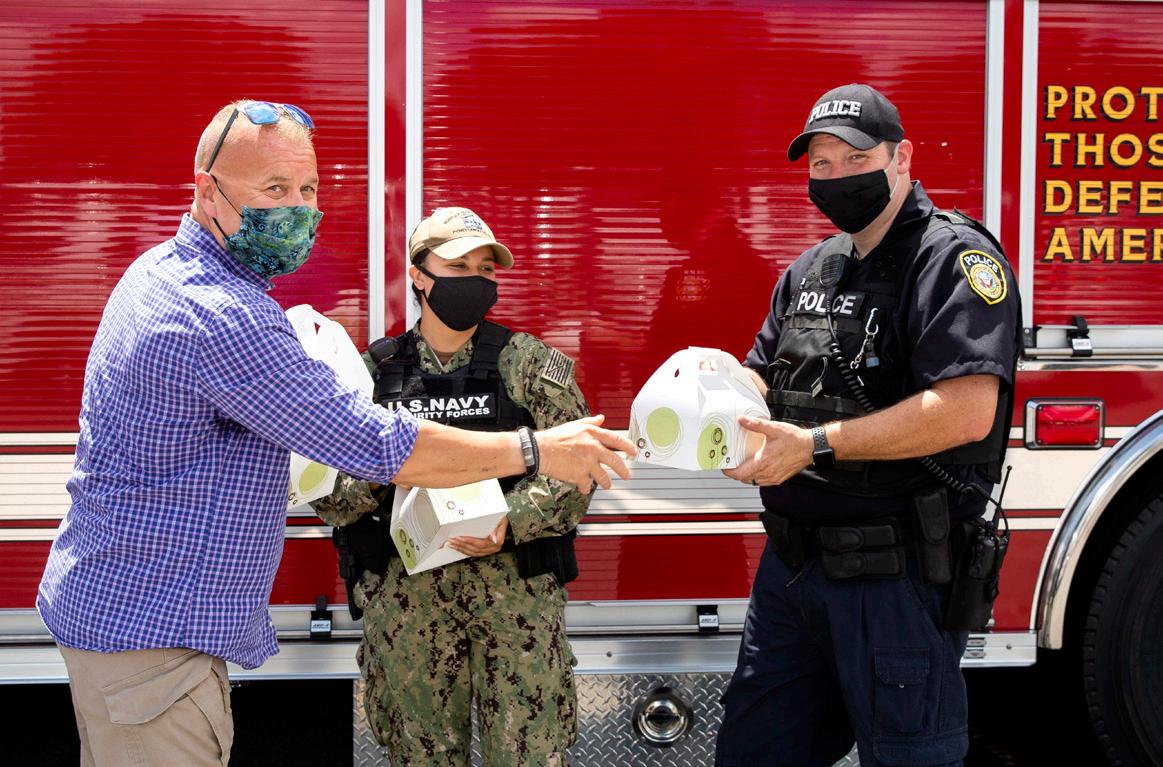
Since 2019, the world has been dealing with the COVID-19 pandemic, yet Norfolk Naval Shipyard (NNSY) has prevailed thus far in continuing its mission to support the Fleet. In an effort to thank the hard-working individuals who have gone above and beyond to ensure the mission continues, NNSY’s Naval Civilian Managers Association (NCMA), National Association of Superintendents (NAS), and Federal Managers Association (FMA) teams worked together with Civilian Morale, Welfare and Recreation, or CMWR (now Morale, Welfare and Recreation, or MWR) to treat some of the shipyard employees who have shone in their response to COVID-19 through tasks such as taking temperatures, producing cleaners, and fabricating face masks and face shields. According to NCMA President Andrew Kirby, the associations first came up with the initiative when they started noticing departments and individuals going out of their way and providing a quick turnaround with solutions to help overcome the challenges that came with the pandemic. “One of these challenges was making the shipyard safe enough for us to come back to work,” Kirby said, “so we wanted to highlight and acknowledge those people who went above and beyond to support the shipyard mission and its C.O.R.E. values by actively caring for their coworkers.” Thankfully, one of the limitations the pandemic had put on the organizations provided a way to do that.
“The associations typically meet on a monthly basis to have a luncheon using some of the membership dues,” Kirby explained. “However, we could not meet in-person due to the pandemic, so we figured, ‘this is money we have available to us now, we have people stepping up and doing good things to help us get back to work. Let’s treat them to lunch.’” Unsurprisingly, when Kirby went to the other organizations to ask for support for the initiative, he received a resounding yes from FMA President Craig Carter and NAS President Charlie McVey, with financial support from their members.
“NAS, NCMA and FMA partner together on a lot of endeavors within the shipyard such as sponsoring different events,” Carter said. “When Kirby reached out to me, I jumped at the chance for FMA to help because we thought it was a great idea to say thank you to some of the people who went above and beyond their normal duties.” Since its first month, the Lunch C.O.R.E. sessions have recognized many groups, such as the Sail Loft and Technology and Innovation (T&I) Community of Practice (COP) for making the masks, the Chemistry Lab that helped create and distribute the new hand sanitizer, and the NNSY Police and Firefighter forces. They do not intend to stop there and are planning to continue this endeavor as long as COVID-19 challenges continue and funding remains available.
The associations plan to partner again with MWR to create vouchers to pass out for honored individuals to spend the voucher when convenient during their shift. “These vouchers are going to work at any of the MWR locations and they can either get a lunch like the ones we have been passing out or use it at the face value price, “ Kirby explained. “For June, we fed around 140 people, and the next headcount is going to be around 201 people. As we go up in numbers, the logistics will get harder. These vouchers will simplify things and be beneficial to the people receiving it.”
Kirby also made sure to note the level of teamwork that went into coordinating the lunches. “I want to highlight Shipyard Infrastructure Optimization Plan (SIOP) Program Office Division Head John Satcher. He’s done the lion’s share of the work in coordinating, picking up, and delivering the lunches with support from the other associations. Additionally, CMWR Business Operation Manager Cris Sigler and her team did an amazing job preparing these lunches, and served as a great partner in realizing this effort.”
Treating people to lunch may not change how dark things may seem, or how unclear the future is, but Kirby says it’s important to make people feel valued. “It’s a small thank you, but it’s just something to show appreciation and demonstrate Care, Ownership and Respect,” Kirby explained.









